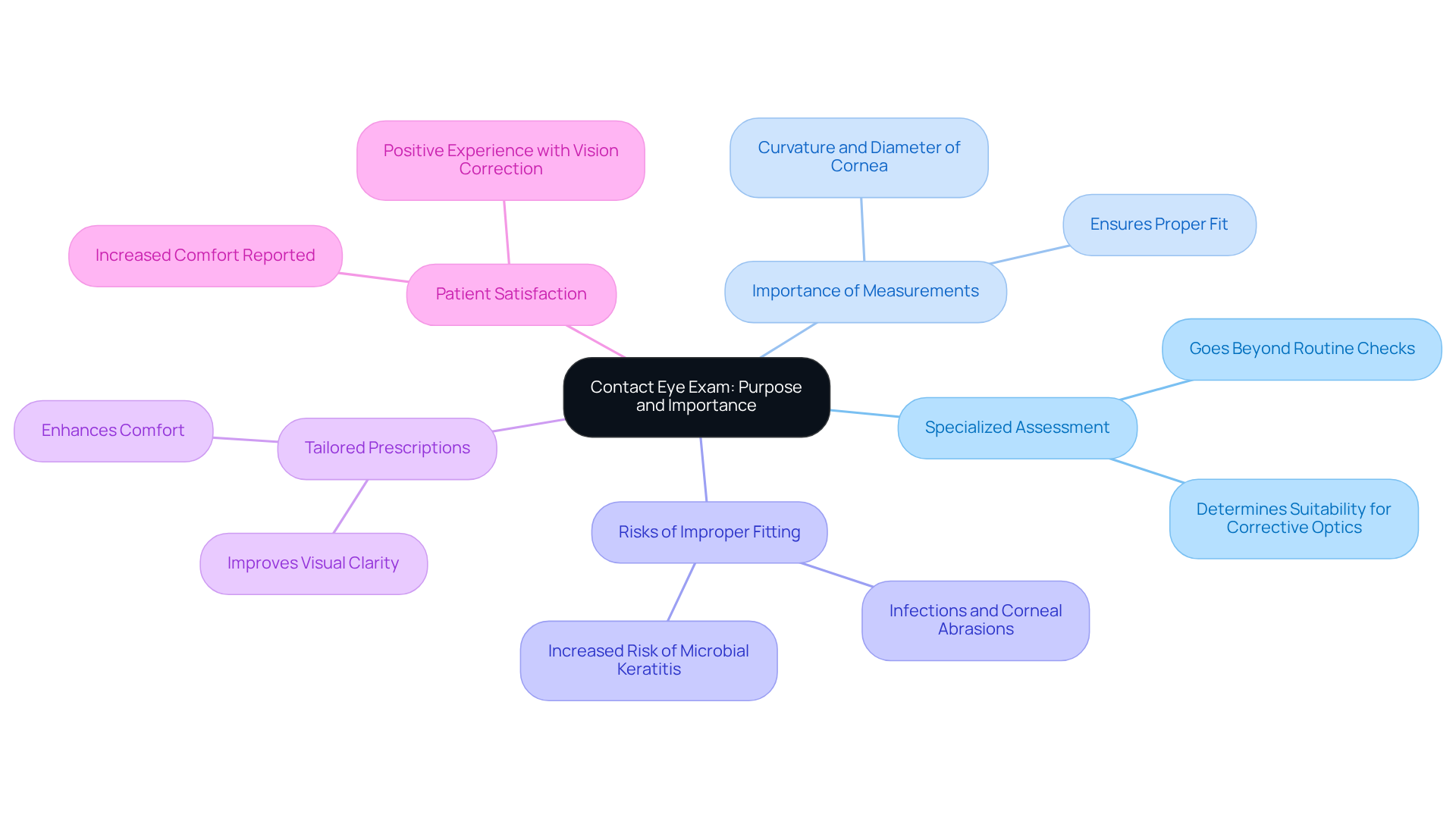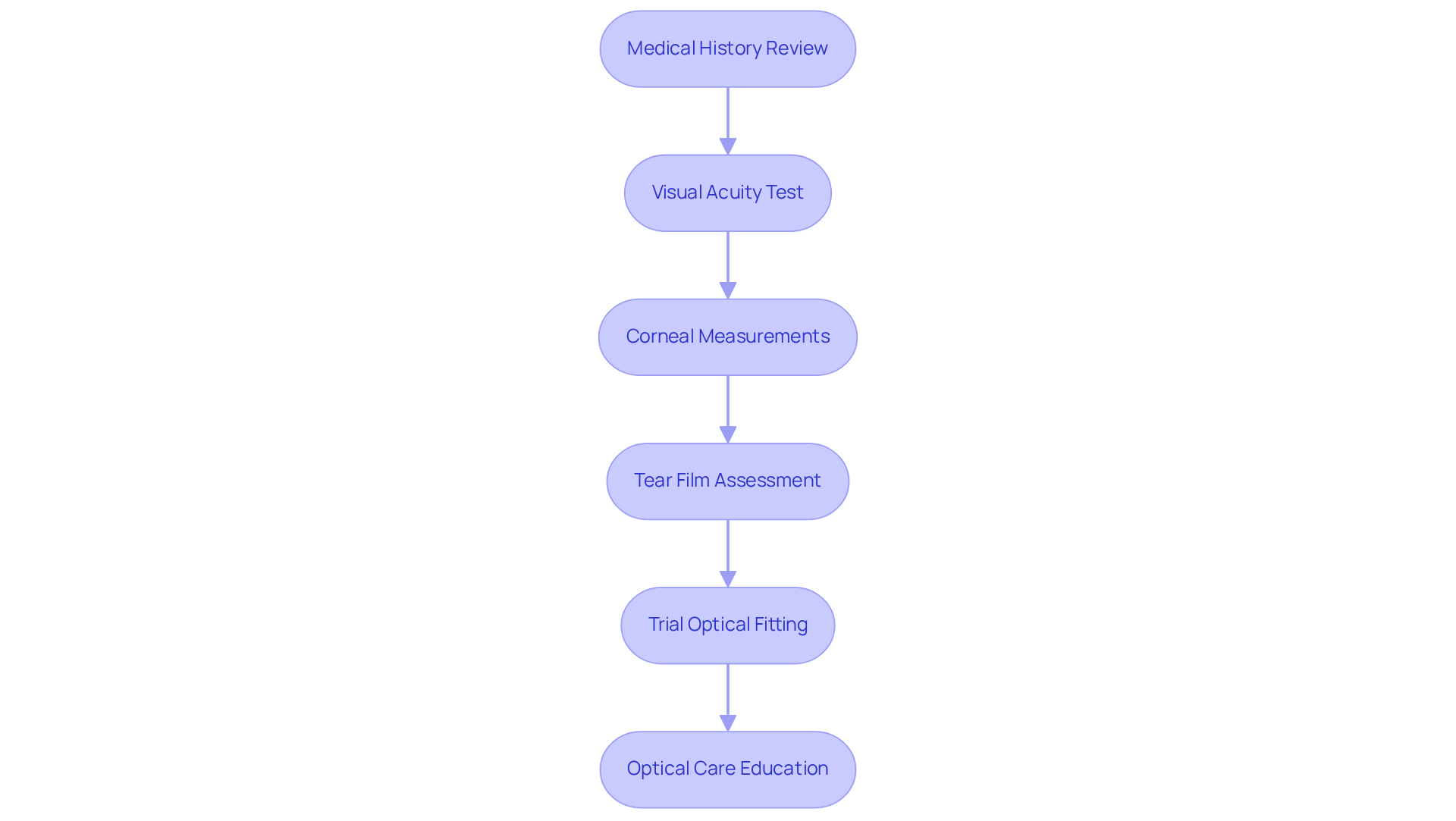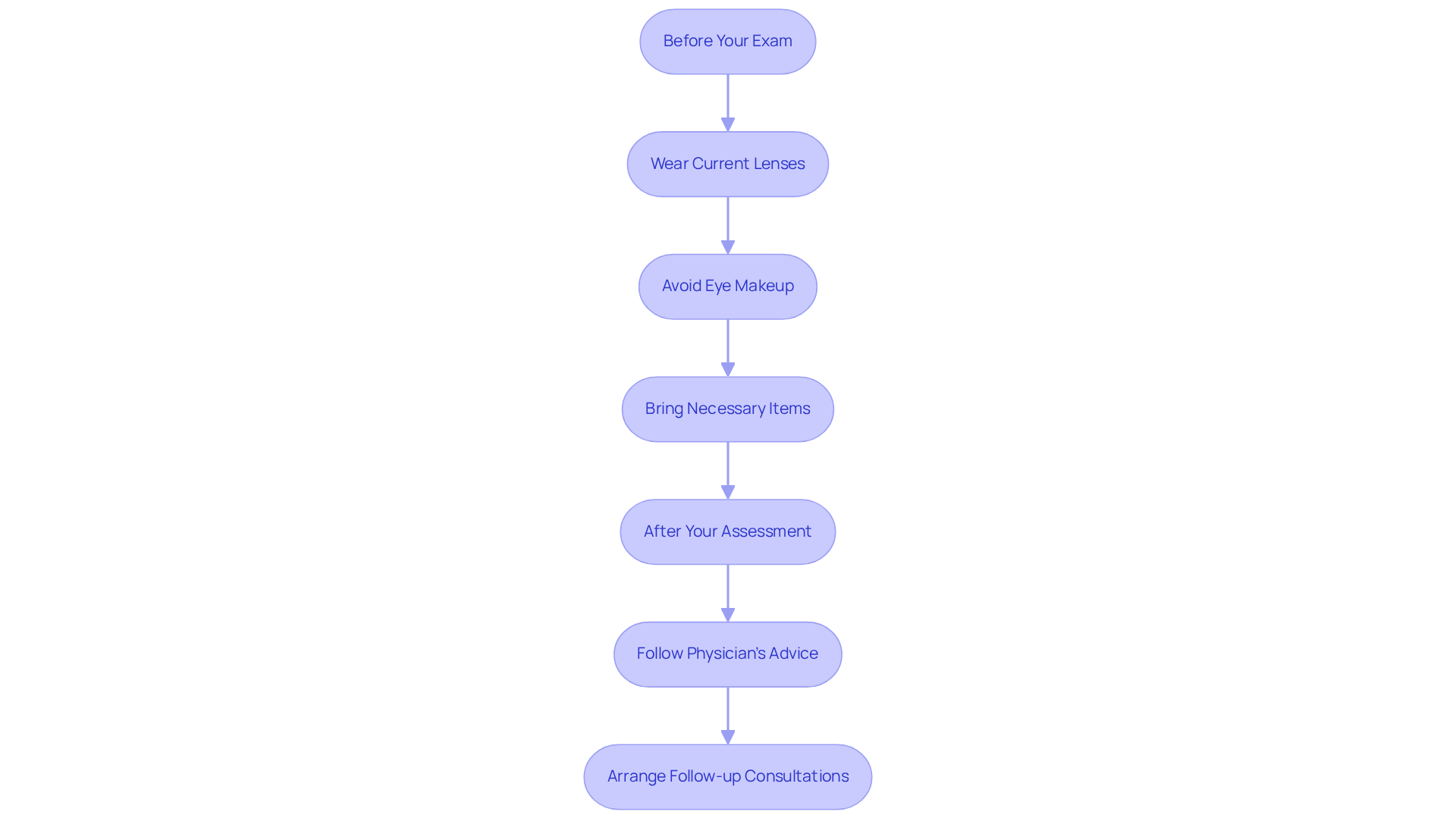Posted by: Northwest Eye in General on October 20, 2025
Overview
A contact eye exam is an essential step in determining your suitability for wearing corrective contact lenses. We understand that this process can be a bit overwhelming, but it focuses on precise measurements of your eyes to ensure your comfort and prevent any complications. This article highlights the importance of this exam, detailing its comprehensive steps, such as corneal measurements and tear film assessment.
These steps are crucial for tailoring the right prescription and enhancing your overall eye health. It’s common to feel uncertain about what to expect, but rest assured, we are here to help you through this process. By understanding your unique needs, we can provide the best care possible, ensuring that you feel confident and well-informed every step of the way.
Introduction
A contact eye exam is not merely a formality; it is a vital assessment that determines the suitability of corrective lenses for your unique needs. We understand that this specialized evaluation can feel overwhelming, as it goes beyond basic eye health checks. It ensures that the lenses fit comfortably and effectively, enhancing your visual clarity and overall eye health.
However, it’s common to feel uncertain about the intricate steps involved and the importance of proper preparation. This can lead to potential discomfort or complications. What essential insights can you uncover to ensure a successful contact eye exam experience? We are here to help you through this process.
Define Contact Eye Exam: Purpose and Importance
A fitting contact eye exam is more than just a routine check; it’s a specialized assessment designed to determine your suitability for wearing corrective optics. This evaluation delves deeper than a standard contact eye exam, which primarily focuses on general eye health and vision improvement. It includes thorough measurements of your eye’s surface, such as the curvature and diameter of the cornea. These details are essential to ensure that your optical devices fit correctly and provide comfort without causing harm.
We understand that many eyewear users experience discomfort, with around one-third reporting at least one healthcare visit for issues like red or painful eyes. Often, these problems stem from improper fitting, which highlights the importance of a comprehensive contact eye exam for vision correction assessment. This evaluation plays a crucial role in preventing complications such as infections and corneal abrasions, which can arise from ill-fitting eyewear. For instance, studies show that the risk of microbial keratitis, a serious eye infection, is significantly higher among those who neglect proper fitting guidelines.
Moreover, this assessment allows eye care specialists to tailor the prescription to your specific needs, enhancing both comfort and visual clarity. Many patients who have undergone a thorough fitting of their optical devices report remarkable improvements in their experience, with increased comfort and satisfaction in their vision correction options. In essence, a comprehensive assessment of vision aids, including a contact eye exam, is vital for preserving your eye health and ensuring a positive experience with your vision correction devices.
We are here to help you through this process, providing the care and support you deserve.

Outline Procedures: Steps Involved in a Contact Eye Exam
The contact eye exam typically involves several key steps designed to ensure a thorough evaluation and a comfortable experience for you:
-
Medical History Review: We begin by discussing your medical background. This includes any past eye issues, current medications, and lifestyle elements that may affect your eyewear usage. We understand that sharing personal information can feel daunting, but it’s essential for your care.
-
Visual Acuity Test: This important examination evaluates how well you can see at different distances. It helps us identify the suitable prescription for your corrective eyewear. It’s common to feel a bit anxious about this test, but rest assured, we are here to support you.
-
Corneal Measurements: Using specialized instruments, we measure the curvature and diameter of your cornea. These precise measurements are crucial for determining the best option for your eyewear, ensuring both comfort and effectiveness.
-
Tear Film Assessment: Assessing the quality and quantity of your tears is vital, as inadequate tear film can lead to discomfort while using eyewear. If you experience dry eye symptoms, we may discuss newer moisture-delivering options during your contact eye exam that could be beneficial for you.
-
Trial Optical Fitting: You’ll often be provided with trial optics to wear during the exam. This allows us to evaluate the fit and comfort of your eyewear, making any necessary adjustments based on your feedback. Your comfort is our priority.
-
Optical Care Education: Finally, you will receive thorough guidance on how to properly maintain your eyewear, including cleaning and storage tips. This education is essential for preserving your eye health and ensuring a positive experience with your corrective eyewear.
This organized approach not only helps you find the most appropriate eyewear but also equips you with the knowledge needed for effective long-term use. We encourage routine follow-up appointments to assess your eyewear performance and address any concerns, highlighting the importance of continuous eye health management. Remember, we are here to help you through this process.

Prepare for Your Exam: What to Know Before and After
Preparing for a vision fitting is an important step towards ensuring a smooth experience. We understand that this process can feel overwhelming, so here are some key considerations to help you succeed:
- Wear Your Current Lenses: If you wear contact lenses, we recommend using them for a few hours before your appointment. This allows your eye care specialist to evaluate their fit and performance effectively.
- Avoid Eye Makeup: On the day of your test, it’s best to skip eye makeup and lotions around your eyes. These products can hinder the fitting process and affect the accuracy of the assessment.
- Bring Necessary Items: Come prepared with your current glasses or contact lenses, a list of medications, and any relevant medical history. This information is vital for your eye care provider to tailor the fitting to your needs.
- Post-Assessment Care: After your assessment, please follow your physician’s advice regarding eyewear usage and maintenance. Arranging follow-up consultations is crucial to monitor your eye health and ensure the eyewear fits correctly.
As one patient shared, “I was so thankful for the advice I received prior to my assessment; it made the process so much easier and helped me grasp the significance of follow-up care.” By following these guidelines, you can enhance your chances of a successful contact eye exam and support your overall eye health. Remember, regular contact eye exams are essential for maintaining good vision and for the early detection of potential issues.

Conclusion
A comprehensive contact eye exam is essential for ensuring that your corrective lenses fit properly and enhance your vision without causing discomfort. We understand that this process may feel daunting, but this specialized assessment goes beyond a standard eye check. It focuses on the unique measurements of your eyes, which are critical for preventing complications and ensuring a positive experience with your eyewear.
Throughout this article, we outlined key procedures of the contact eye exam, including:
- A thorough medical history review
- Visual acuity testing
- Corneal measurements
- Tear film assessments
Each step is designed with your individual needs in mind, ultimately leading to improved comfort and satisfaction with your contact lenses. Additionally, we emphasized the importance of preparation and post-exam care, highlighting how proactive measures significantly contribute to the overall success of the fitting process.
Investing time in a detailed contact eye exam not only safeguards your eye health but also enhances your quality of vision. We encourage you to commit to regular check-ups and follow care guidelines, as these steps can lead to a more enjoyable experience with your corrective lenses. By taking these steps today, you prioritize your eye health for a clearer, more comfortable tomorrow.
Frequently Asked Questions
What is the purpose of a contact eye exam?
A contact eye exam is a specialized assessment designed to determine your suitability for wearing corrective optics. It goes beyond a standard eye exam by focusing on specific measurements of the eye’s surface to ensure proper fitting and comfort.
How does a contact eye exam differ from a standard eye exam?
Unlike a standard eye exam, which primarily assesses general eye health and vision improvement, a contact eye exam includes thorough measurements of the cornea’s curvature and diameter to ensure that contact lenses fit correctly and safely.
Why is a comprehensive contact eye exam important?
A comprehensive contact eye exam is important because it helps prevent complications such as infections and corneal abrasions that can arise from ill-fitting eyewear. It also allows eye care specialists to tailor prescriptions to individual needs, enhancing comfort and visual clarity.
What issues can arise from improper fitting of contact lenses?
Improper fitting of contact lenses can lead to discomfort, red or painful eyes, and increased risk of serious eye infections like microbial keratitis. Many users experience healthcare visits due to these issues.
What improvements can patients expect after a thorough fitting of their optical devices?
Patients who undergo a thorough fitting of their optical devices often report remarkable improvements in comfort and satisfaction with their vision correction options.
How can a contact eye exam contribute to preserving eye health?
A contact eye exam contributes to preserving eye health by ensuring that vision correction devices fit properly, reducing the risk of complications and enhancing the overall experience with these devices.






